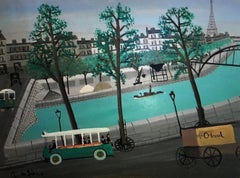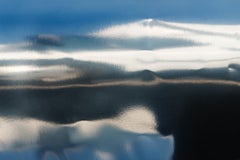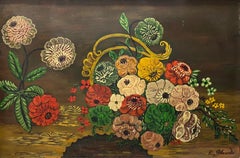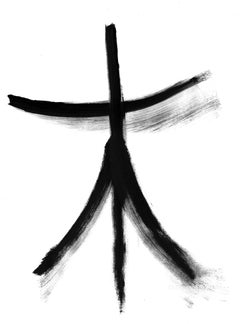Switzerland - Art
to
884
1,857
934
1,030
567
1,106
Overall Width
to
Overall Height
to
18
127
2,890
2,459
21
34
80
98
189
275
436
289
160
194
17
1,512
943
766
229
228
167
94
60
56
33
28
20
17
1
2,699
2,168
423
1,905
1,083
703
600
548
479
454
444
411
332
304
262
246
217
217
212
184
167
152
132
2,419
1,794
662
569
468
180
114
103
95
93
1,623
1,553
232,790
151,428
Item Ships From: Switzerland
Jean Cocteau (after) - Europe Our Country - Lithograph
By Jean Cocteau
Located in Collonge Bellerive, Geneve, CH
Lithograph after a drawing by Jean Cocteau
Title: Europe Our Country
Signed in the plate
Dimensions: 33 x 46 cm
Edition: 600
Luxury print edition from the portfolio of Sciaky
1961
Category
1960s Post-Modern Switzerland - Art
Materials
Lithograph
Edge of the lively Seine, Paris
By Armand Marie Guerin
Located in Genève, GE
Work on wood
Category
Early 20th Century French School Switzerland - Art
Materials
Oil
"Ironic Iconic" Expression Acrylic Painting Hollywood Pop Art 100x100x4cm
By Anastasia Vasilyeva
Located in Zofingen, AG
An ironic reflection on Hollywood stars and the stock and fund market.
A new interpretation on the theme of pop art style.
This painting is meant to be ironic, reflecting on what "ic...
Category
2010s Pop Art Switzerland - Art
Materials
Oil Pastel, Acrylic
Mirage – Dominique Teufen, Photography, Abstract, Landscape, Colour, Art
By Dominique Teufen
Located in Zurich, CH
Dominique TEUFEN (*1975, Switzerland)
Mirage, from the series 'Rays of Light', 2019
Hahnemühle Fine Art Baryta
Sheet 80 x 120 cm (31 1/2 x 47 1/4 in.)
Frame 91 x 130 x 4 cm (35 7/8 x...
Category
2010s Contemporary Switzerland - Art
Materials
Pigment
Still life flemish school by Roberto Gherardi - Oil on wood 47x69 cm
By Roberto Gherardi
Located in Geneva, CH
Work on wood with frame
Total size with frame: 60x82x7 cm
Roberto Gherardi is a Geneva Artist born in 1933
Category
1980s Flemish School Switzerland - Art
Materials
Oil
$680 Sale Price
20% Off
Black White Abstraction 019 Painting by Anastasia Vasilyeva, 2020
By Anastasia Vasilyeva
Located in Zofingen, AG
Anastasia Vasilyeva - Black white abstraction 019 (2020)
Painting on high quality, acid free, high density paper. Conceptual minimalist abstract painting designed in calligraphic st...
Category
21st Century and Contemporary Abstract Geometric Switzerland - Art
Materials
Paper, Acrylic
Leonor Fini - Playful Cat - Original Handsigned Lithograph
By Leonor Fini
Located in Collonge Bellerive, Geneve, CH
Leonor Fini - Playful Cat - Original Handsigned Lithograph
Les Elus de la Nuit
1986
Conditions: excellent
Handsigned and Numbered
Edition: 230
Dimensions: 38 x 28 cm
Editions: Trinc...
Category
1980s Modern Switzerland - Art
Materials
Lithograph
Naked man posing seated
Located in Genève, GE
Work on canvas laid down on panel
Wooden frame and gilded plaster
100 x 70.5 x 4 cm
Category
20th Century Switzerland - Art
Materials
Oil
Le chateau de Chillon, Switzerland by Albert Emil Kirchner - Engraving 20x27 cm
Located in Geneva, CH
Engraving by Albert Emil Kirchner Dutch artist born in 1813 and died on 1885
He have 176 registered auctions. The oldest was in 1989 and the most recent in 2022
The theme of the engraving is one of the most famous castle in Switzerland "le chateau...
Category
1850s Realist Switzerland - Art
Materials
Engraving
Paysage, Pablo Picasso, 1950's, Plate, Design, Ceramic, Figuratif, Editions
By Pablo Picasso
Located in Geneva, CH
Paysage, Pablo Picasso, 1950's, Plate, Design, Ceramic, Figuratif, Editions
Paysage
Ed.200 pcs
08.12.1953
White earthenware clay, decoration in engobes, knife engraved, under glaze
...
Category
1950s Post-War Switzerland - Art
Materials
Ceramic, Earthenware
Joan Miro - Original Abstract Lithograph from the book "Miro Lithographe III"
By Joan Miró
Located in Collonge Bellerive, Geneve, CH
Joan Miro Miro Original Abstract Lithograph
Artist: Joan Miro
Medium: Original lithograph on Rives vellum
Portfolio: Miro Lithographe III
Year: 1976
Edition: 5,000
Image Size: 10" x ...
Category
1970s Abstract Switzerland - Art
Materials
Lithograph
Kate Moss Frontal Nude 3 – Albert Watson, Nude, Photography, Black&White, Woman
By Albert Watson
Located in Zurich, CH
Albert WATSON (*1942, Scotland)
Kate Moss, Frontal Nude III, 1993
Chromogenic print
Sheet 243 x 183 cm (95 5/8 x 72 in.)
Edition of 5; Ed. no 2/5
Print only
Albert Watson was born 1...
Category
1990s Contemporary Switzerland - Art
Materials
C Print
Paul Jouve - Eagle - Original Engraving
By Paul Jouve
Located in Collonge Bellerive, Geneve, CH
Paul Jouve - Eagle - Original Engraving
Editions Rombaldi, Paris, 1950.
Copy on velin creme de Rives
Artwork by Paul Jouve.
Original copper engraving heightened with pochoir.
Paul...
Category
1950s Modern Switzerland - Art
Materials
Engraving
Still life with wicker baskets
Located in Genève, GE
Work on wood
Golden wooden frame
74 x 87 x 5 cm
Category
1970s Switzerland - Art
Materials
Oil
Red and black composition by Gilbert Pauli - Mixed media 83x75 cm
By Gilbert Pauli
Located in Geneva, CH
Four oils on canvas glued on an aluminium plate tinted by acrylique
Born in 1944 in the canton of Fribourg, Gilbert Pauli currently lives in Geneva, where he devotes himself to pai...
Category
Early 2000s Conceptual Switzerland - Art
Materials
Canvas, Oil, Acrylic
$1,320 Sale Price
20% Off
Summer Sale Teal Old Schoolboard with math Science Art Collection Abstract Art
By Anastasia Vasilyeva
Located in Zofingen, AG
This artwork is painted in the form of a classical school board with math equations. It is a part of the Science Art Collection by Anastasia Vasilyeva.
The painting's size is 100x100...
Category
2010s Abstract Expressionist Switzerland - Art
Materials
Oil Pastel, Acrylic
The model
Located in Genève, GE
Work on canvas
Molded frame in plaster and gilded wood
72 x 56 x 6 cm
Category
1950s Switzerland - Art
Materials
Oil
Poisson Chiné (A.R. 170), Pablo Picasso, Design, Ceramic, Madoura
By Pablo Picasso
Located in Geneva, CH
PABLO PICASSO
Poisson chiné (A.R. 170), 1952
Ed. 200 pcs
White earthenware clay, decoration in engobes under partial brushed glaze. Grege, blue, mat green
Stamped on the back : Edi...
Category
Mid-20th Century Modern Switzerland - Art
Materials
Ceramic
The Entry of Jesus to Jerusalem
By Gilbert Pauli
Located in Geneva, CH
Born in 1944 in the canton of Fribourg, Gilbert Pauli currently lives in Geneva, where he devotes himself to painting and sculpture, a passion he developed from his childhood. His fa...
Category
1990s Art Deco Switzerland - Art
Materials
Oil
$960 Sale Price
77% Off
Couple on a walk around the pond with dog and swans
Located in Genève, GE
Work on canvas
Gray and gold wooden frame
71.5 x 91.5 x 4.5 cm
Category
Early 20th Century Switzerland - Art
Materials
Oil
Ecstasy of Saint Teresa
Located in Zofingen, AG
ABOUT THE ARTWORK
"Ecstasy of Saint Teresa" is an evocative piece that captures the transcendental moment of spiritual rapture. The central figure, poised in a state of divine surren...
Category
2010s Impressionist Switzerland - Art
Materials
Canvas, Oil
Scent of Spring: Immersion into the World of Spring Emotions
Located in Zofingen, AG
Oil on wood. "Scent of Spring: Immersion into the World of Spring Emotions"
On this canvas, we immerse ourselves in the enchanting realm of spring. In the foreground, like the main...
Category
21st Century and Contemporary Impressionist Switzerland - Art
Materials
Canvas, Paint, Lights, Oil, Wood Panel
Path through fields by Aymar - Oil on canvas 38x60 cm
Located in Geneva, CH
XX ° century painter
Work on canvas
Gilded wood frame
53 x 75 x 6 cm
Category
1970s Modern Switzerland - Art
Materials
Oil
$1,680 Sale Price
32% Off
Bouquet of roses by Benjamin II Vautier - Oil on wood 30x40 cm
By Benjamin II Vautier
Located in Geneva, CH
Work on wood sold with frame
Category
1970s Modern Switzerland - Art
Materials
Oil
At Satigny station, Geneva
Located in Genève, GE
Work on canvas
Golden wooden frame
86 x 105 x 4 cm
Category
Mid-20th Century Switzerland - Art
Materials
Oil
Delicate bouquet of flowers Oil abstract interior painting Modern Impressionist
Located in Zofingen, AG
Oil on canvas
In "Sunny Emotions: A Bouquet of Wildflowers in the Sunlight" we see a beautiful bouquet consisting of wildflowers, bathed in the sunlight.
The painting conveys an a...
Category
21st Century and Contemporary Impressionist Switzerland - Art
Materials
Paint, Lights, Oil
Italian landscape
Located in Genève, GE
Signed
Work on cardboard
Plaster and gilded wood frame
25.5 x 31.5 x 4.5 cm
Category
Late 19th Century Italian School Switzerland - Art
Materials
Oil
Return from hunting
Located in Genève, GE
Work on canvas
Black wooden frame
86 x 74 x 3 cm
Category
19th Century Switzerland - Art
Materials
Oil
$2,031
The four militaries By Hippolyte Bellangé - Antique oil on canvas
By Hippolyte Bellangé
Located in Geneva, CH
The work is old, dated from the middle of the 19th century. The artist has been sold more than 300 times in auction houses, mainly in France (origin of the painter), which explains t...
Category
Mid-19th Century Realist Switzerland - Art
Materials
Oil
$1,152 Sale Price
42% Off
Geneva countryside
Located in Genève, GE
Work on canvas
Wooden frame
74 x 61.5 x 4 cm
Category
1930s Modern Switzerland - Art
Materials
Oil
Poppies Of The Rhine Valley. Horizontal, impressionism, landscape, flowers
Located in Oslo, NO
"In my paintings I capture the wild beauty of a blooming field where the vibrant red of the poppies shines." said Anna Shesterikova about this artwork. "The oil paints allow me to de...
Category
2010s Post-Impressionist Switzerland - Art
Materials
Oil
Paul Wunderlich - Leaf - Signed Bronze Sculpture
By Paul Wunderlich
Located in Collonge Bellerive, Geneve, CH
Paul Wunderlich
Leaf
Bronze Sculpture
Signed, Numbered 248/350
Dated 1979
Paul Wunderlich, (1927 - 2010)
Born in Eberswalde on 10 March 1927. The German painter studied at the K...
Category
1970s Abstract Expressionist Switzerland - Art
Materials
Bronze
Salvador Dali - Serenade - Lithograph
By Salvador Dalí
Located in Collonge Bellerive, Geneve, CH
Salvador Dali - Serenade - Original Handsigned Lithograph
Dimensions: 51 x 71 cm
1970
Signed in pencil and numbered
Edition : /CXX
References : Field 70-8
Category
1970s Surrealist Switzerland - Art
Materials
Lithograph
Portrait of young girl
By Henri Fehr
Located in Genève, GE
Work on paper
Brown wooden frame with glass pane
48 x 39 x 1.5 cm
Category
Mid-20th Century Switzerland - Art
Materials
Pastel
Gondolier and Sunny Morning in Venice
Located in Zofingen, AG
In this passionate dance of color and texture, I've depicted a scene that ignites the senses, where gondolas float in a dreamscape of fiery hues. Each stroke blends acrylic and oil t...
Category
2010s Impressionist Switzerland - Art
Materials
Oil, Canvas, Acrylic
Landscape with Boats by Paul Delapoterie - Oil on wood 38x61 cm
Located in Geneva, CH
Paul Delapoterie, born in 1930, is a painter from Geneva, Switzerland. His work spans various styles, including abstract landscapes, figurative portraits, and surrealist pieces. Know...
Category
Mid-20th Century Modern Switzerland - Art
Materials
Wood, Oil
$1,256 Sale Price
20% Off
Visage no.111 (A.R. 476), Pablo Picasso, Design, Ceramic, Madoura
By Pablo Picasso
Located in Geneva, CH
PABLO PICASSO
Visage no.111 (A.R. 476), 1963
Ed. 500 pcs
Decor with engobes and enamel under cover black, green, blue and red decor
D. 25.5 cm I D. 10 in
D. 33.2 cm I D. 13 1/8 in (...
Category
20th Century Modern Switzerland - Art
Materials
Ceramic, Earthenware
Leda and the Swan
Located in Genève, GE
Leda and Swan
This captivating work depicts a mythological scene in which a nude woman lies on a beach, entwined with a majestic swan. The color palette, dominated by gray and beige...
Category
1960s Switzerland - Art
Materials
Watercolor
Congratulations / Abstract / impasto interior painting /
Located in Zofingen, AG
It is an original impasto painting. Acrylic on high-quality canvas (40/40 cm). Color on computer monitors may vary. The sides of the artwork painted as a part of the composi...
Category
2010s Abstract Impressionist Switzerland - Art
Materials
Acrylic
$389 Sale Price
44% Off
The farm by J. Mossaz - Oil on canvas 55x43 cm
Located in Geneva, CH
J. Mossaz is a Geneva artist from the 20th century.
Work on canvas sold with frame
Total size with frame 49x62 cm
Category
Mid-20th Century Modern Switzerland - Art
Materials
Oil
$640 Sale Price
20% Off
Überwölbt (Abstract Painting)
Located in London, GB
Überwölbt (Abstract Painting)
Acrylic on canvas - Framed
Canvas size: 100 x 160 x 2 cm / 43.3 x 63 x 0.7 inch
Andreas Durrer is a Swiss abstract painter. His work is characterised...
Category
2010s Abstract Switzerland - Art
Materials
Canvas, Acrylic
Country lane
Located in Genève, GE
Work on canvas
Beige wooden frame
47 x 53 x 4.7 cm
Category
Early 20th Century Switzerland - Art
Materials
Oil
Theodora by Damien Hirst, The Empresses, Red Butterflies kaleidoscope effect
By Damien Hirst
Located in Zug, CH
“The Empresses” is a series of five glorious artworks named after influential female rulers. They are composed of butterfly wings placed on a flaming red background which create a ka...
Category
2010s Young British Artists (YBA) Switzerland - Art
Materials
Glitter, Giclée
69YK #15 – Nobuyoshi Araki, Japanese Photography, Nude, Black and White, Art
By Nobuyoshi Araki
Located in Zurich, CH
Nobuyoshi ARAKI (*1940, Japan)
69YK #15, 2009
Gelatin silver print
50.8 x 60 cm (20 x 23 5/8 in.)
Print only
Nobuyoshi Araki (Tokyo, 1940) is a Tokyo-based photographer. Araki completed his studies at Chiba University’s Department of Photography, Painting and Engineering with a focus on the study of film and photography. His photographic project Satchin earned him the prestigious Taiyo Award in 1964, shortly after he had joined the advertising agency Dentsu, where he worked until 1972. At Dentsu he met his wife Yoko, to whom he paid homage in Sentimental Journey, a photographic record of their honeymoon published in 1971. Eros and thanatos (sex and death) has been a central theme in Araki’s work; an abiding fascination with female genitalia and women’s bodies in Japanese bondage...
Category
Early 2000s Contemporary Switzerland - Art
Materials
Black and White, Silver Gelatin
Village under the snow
Located in Genève, GE
Work on cardboard
Silver wooden frame
33.5 x 48.5 x 2 cm
This captivating work of art, depicting a winter landscape, is distinguished by its attention to detail and balanced composit...
Category
1930s Switzerland - Art
Materials
Oil
Plaster and ceramic composition by Gilbert Pauli - Mixed media 61x78 cm
By Gilbert Pauli
Located in Geneva, CH
Born in 1944 in the canton of Fribourg, Gilbert Pauli currently lives in Geneva, where he devotes himself to painting and sculpture, a passion he developed from his childhood. His fa...
Category
Early 2000s Abstract Switzerland - Art
Materials
Ceramic, Plaster, Acrylic
$1,056 Sale Price
20% Off
Horse
Located in Genève, GE
Work on paper
Category
Mid-20th Century Switzerland - Art
Materials
Crayon
In full swing n°2 by John Torcapel - Gouache on paper 37x25 cm
Located in Geneva, CH
Work on paper
Category
Mid-20th Century Modern Switzerland - Art
Materials
Gouache
$168 Sale Price
20% Off
Sailboats on the lake in a busy landscape
Located in Genève, GE
Work on canvas
Category
1890s Switzerland - Art
Materials
Oil
Fruitful (Large) by Damien Hirst, Colourful, Giclée Print, Contemporary Art
By Damien Hirst
Located in Zug, CH
This vibrant work features abstract details from Damien Hirst's series of Cherry Blossom paintings and reinterprets the traditional subject of landscape painting.
Damien Hirst
Fruit...
Category
2010s Young British Artists (YBA) Switzerland - Art
Materials
Giclée
$3,071 Sale Price
52% Off
Bouquet in carafe and fruits by Alexandre Rochat - Gouache on paper 53x74 cm
By Alexandre Rochat
Located in Geneva, CH
Work on paper
Gilded wood frame with glass pane
85 x 65 x 3 cm
Category
Mid-20th Century Modern Switzerland - Art
Materials
Gouache
Black White Abstraction 006 Painting by Anastasia Vasilyeva, 2019
By Anastasia Vasilyeva
Located in Zofingen, AG
Anastasia Vasilyeva - Black white abstraction 006 (2019)
Painting on high quality, acid free, high density paper.
Conceptual minimalist abstract painting designed in calligraphic st...
Category
21st Century and Contemporary Abstract Expressionist Switzerland - Art
Materials
Paper, Acrylic
Linear Development by Victor Heath-Leytron - Oil on paper 58x58 cm
Located in Geneva, CH
Work on paper
Category
1970s Abstract Switzerland - Art
Materials
Oil
Small country lane
By Henry Meylan
Located in Genève, GE
Work on canvas
This artistic work depicts a captivating rural scene, imbued with tranquility and simplicity. In the center of the composition, a dirt road invites the viewer to get lost in this picturesque landscape. Earthy tones dominate the canvas, evoking an autumnal or winter atmosphere, where leaves are absent, leaving bare branches dancing in the gray sky. The house with its red roofs immediately catches the eye, contrasting with the shades of browns and greens in the rest of the painting. This pop of bright color serves as a focal point, suggesting warmth and refuge beyond the apparent coldness of the surroundings. The trees, stripped of their foliage, stand on either side of the path, forming a sort of natural corridor that guides the eye towards the background. The juxtaposition of the stone walls on the left and the wooden fence on the right creates a visual tension between nature and human architecture, reflecting a harmony typical of country landscapes. The use of light is subtle but effective, casting a soft glow that envelops the scene in a soft and serene aura. The cloudy sky brings an additional dimension, accentuating the impression of calm and silence...
Category
Late 20th Century Switzerland - Art
Materials
Oil
CSO Verbier 1999 by Archiguille - Print
By Archiguille
Located in Geneva, CH
Reproduction of poster against signed and numbered
30/100
Category
1990s Modern Switzerland - Art
Materials
C Print
$528 Sale Price
20% Off
The poet
By Guglielmo Innocenti
Located in Genève, GE
Work on paper
Support size
22 x 22 x 0.4 cm
Category
20th Century Italian School Switzerland - Art
Materials
Crayon
Dahlias by Roger Delapierre - Oil on canvas 46x55 cm
By Roger Delapierre
Located in Geneva, CH
Roger Delapierre was born in Geneva in 1935. ... Roger Delapierre's painting has reached full maturity and the success of his exhibitions has proven i...
Category
1990s Academic Switzerland - Art
Materials
Oil
$544 Sale Price
78% Off
Black White Abstraction 011 Painting by Anastasia Vasilyeva, 2019
By Anastasia Vasilyeva
Located in Zofingen, AG
Anastasia Vasilyeva - Black white abstraction 011 (2019)
Painting on high quality, acid free, high density paper.
Conceptual minimalist abstract painting designed in calligraphic st...
Category
21st Century and Contemporary Abstract Expressionist Switzerland - Art
Materials
Paper, Acrylic
Still life by Benjamin II Vautier - Oil on canvas 50x61 cm
By Benjamin II Vautier
Located in Geneva, CH
Oil on canvas sold with frame
Total size with frame 70x81 cm
Benjamin II VAUTIER is an artist born in Switzerland in 1895 and died in 1974. His w...
Category
Mid-20th Century Impressionist Switzerland - Art
Materials
Oil
$528 Sale Price
56% Off
Still life with fruit
Located in Genève, GE
Illegible signature
Work on canvas
Category
1960s Modern Switzerland - Art
Materials
Oil
Recently Viewed
View AllMore Ways To Browse
John F Herring
John Van Hamersveld
Jose Vives Atsara Paintings
Jose Vives Atsara
Julyan Davis
L Ryder
Larry Fanning
Luis R Cuevas
Maine Lobster
Marc Chagall The Blue Sky Signed
Martin Cottage Painting
Mayhew Painting
Mens Vintage Military Jacket
Metropolis Vintage Poster
Morrow Oil
Mr Doodle
Noyes George
Oil Pump Vintage




